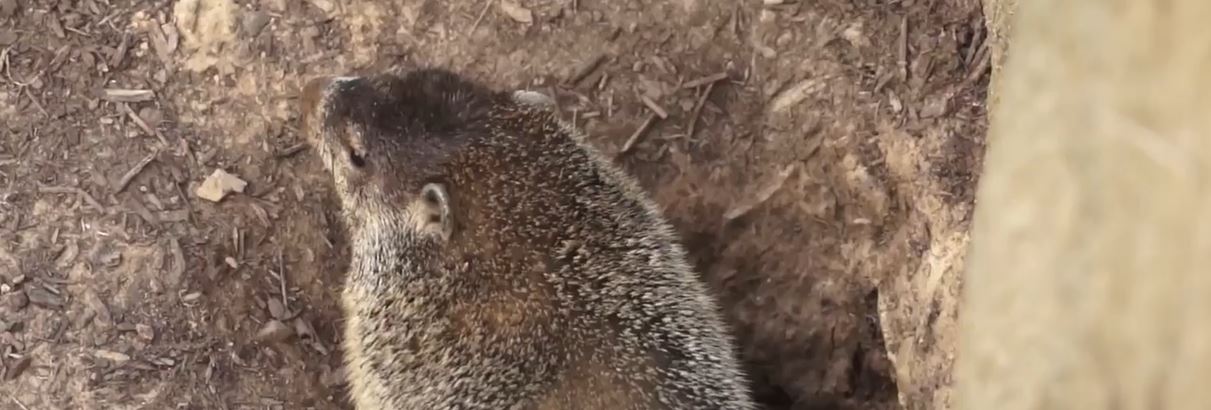About Groundhogs: Appearance, Biology, Life Cycle, Habitat, Diet, And Behavior

Depending on where you live, groundhogs are one of many potential wild animals that can invade your property or even your home. The groundhog is also known as the woodchuck and is a type of marmot. They are known for their feast-or-famine lifestyle and their key role in groundhog's day for predicting the end of winter.
Appearance
Groundhogs tend to weigh around 13 pounds and have a head and body between 17.75 and 24 inches. Their tail is between 7 and 9.75 inches. In areas with fewer predators and more food, they may grow up to 32 inches and 30 pounds. They have brown fur and a round body featuring a small and bushy tail. Groundhogs have strong legs and their curved claws make burrowing easy. Their eyes are small and round and their ears are at the top of their flat head. Their two long incisors will always grow, meaning that groundhogs have to chew on wood or other items. They also have two separate coats of fur. The dense gray undercoat is found underneath the longer guard hair coat that most people recognize.
Biology And Life Cycle
Groundhogs give birth to around two to nine pups in the spring. These babies will remain with their mother until they are several months old. Mating takes place during the early spring after the animals leave hibernation with pregnancy lasting between 28 and 32 days. Both the male and female will remain together in the den until the pups are about to be born.
When they are born, the pups are blind, naked, and helpless, measuring under 4 inches long. By 4 weeks old, they will open their eyes but tend not to leave the den until they reach 6 or 7 weeks. In midsummer, young groundhogs may start digging starter burrows close to home before moving further away by late summer. It is most common for groundhogs to start reproducing once they are two years old, but some will do so in their first year. In the wild, groundhogs will usually live about 3 to 6 years.
Habitat
Groundhogs tend to live in areas where woodlands connect with open spaces. This makes streams, roads, and fields ideal. They are found throughout the eastern and central United States, extending into Alaska and Canada. Groundhogs live in complex burrow systems that they dig into well-drained, dry soil. They tend to pick areas close to cover for their burrows, so you are likely to find them close to hedgerows, trees, fencerows, and home foundations.
Their burrows are complex and feature multiple chambers. They are able to dig these complex homes thanks to their sharp claws and store food there as well as using the area for nesting and hibernation. It is possible for each burrow or den to require the groundhog to excavate 700 pounds of dirt and some groundhogs will make multiple dens within their territory. You can typically spot a groundhog den entrance by the small mound with exposed dirt. To tell if it is active, look for loose soil.
Diet
Groundhogs will eat a great deal during the summer months as this allows them to build up fat reserves. Then, when the first frost comes, they enter their burrows and hibernate for the winter. When living by streams, roads, and fields, groundhogs will typically eat plants and grasses such as tree bark and fruits. Because of their large appetite, groundhogs can completely destroy a field or plot of land. The average groundhog eats about a third of its weight in vegetation daily.
Groundhogs are mostly herbivores, but they will occasionally eat insects although this makes up a very small portion of their diet. Some of the many foods groundhogs enjoy include peas, beans, apples, dandelions, flowers, carrot tops, garden vegetables, clover, and bark. Groundhogs do not drink a lot of water; instead, they get most moisture from leaves and other plants.
Behavior
Groundhogs tend to enter hibernation at the first frost, sometime around October, staying until early spring. At this point, their body temperature goes from 99 degrees Fahrenheit to 40 degrees and their heartbeat drops from about 80 beats a minute to just 5. During hibernation, groundhogs live off their fat reserves.
As members of the same family as squirrels, groundhogs are great climbers and they can also swim. Despite this, you will typically see them on the ground. Groundhogs are active during the day between spring and fall. They are most active early in the morning or early in the evening, which is when they tend to leave their burrows to collect food.
Groundhogs are fairly solitary in nature so you will typically only find them in groups during the mating season or when there is a mother with her babies. They still, however, work together for protection and are highly alert when outside their dens. An example would be their high-pitched shrills that warn nearby groundhogs of potential threats.
Read the How to get rid of groundhogs page for helpful information and to learn more about About Groundhogs: Appearance, Biology, Life Cycle, Habitat, Diet, And Behavior

